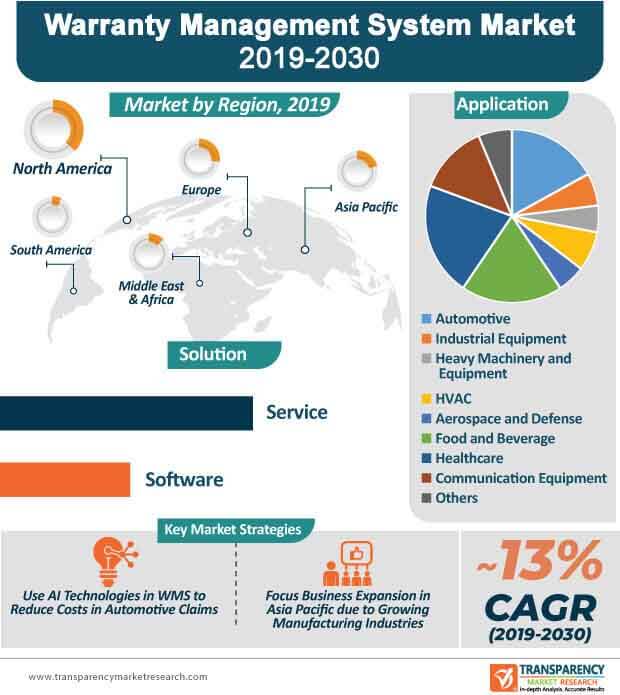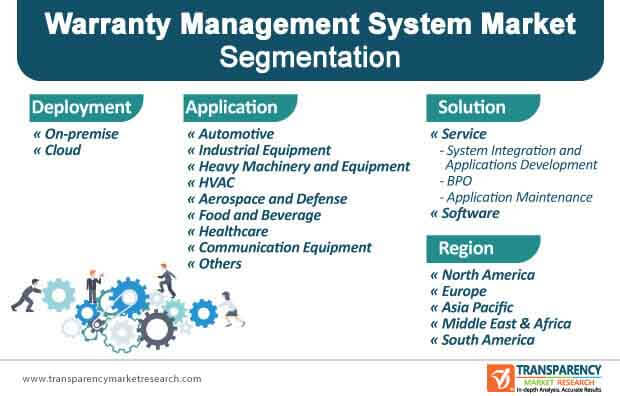Warranty Management System Market : Investigation Reveals Contribution By MajorPosted by Mayuri on November 12th, 2020 Vendors Establish Coronavirus Response with Remote Working Resources to Ensure Business ContinuityCompanies in the warranty management system market are fulfilling business continuity plans amidst the COVID-19 (coronavirus) outbreak. They are maintaining operational readiness to address challenges created by the pandemic. In order to ensure employee and partner safety, companies in the warranty management system market are adhering to guidelines issued by local governments and health organizations to successfully contain the spread of the coronavirus. Seamless and robust remote working environments are being established for employees to ensure secure collaboration between teams. Companies are adopting tools and resources that facilitate remote working so that employees can address the issues and requests of their partners and customers. They are establishing a highly distributed workforce to deliver the highest level of support and services to partners. Employees are closely monitoring all logged calls and support requests from its customers, while working remotely amidst the coronavirus pandemic.  Request For Sample @ https://www.transparencymarketresearch.com/sample/sample.php?flag=S&rep_id=4664 AI and ML Warranty Intelligence Deploys Actionable Insights for Product Improvement Next-gen warranty management systems (WMS) are integrated with artificial intelligence (AI) and machine learning (ML) capabilities to ensure customer satisfaction. For instance, California-based software company Tavant Technologies is promoting its end-to-end warranty management system that helps organizations reduce warranty costs and improve aftermarket experience. Thus, AI and ML innovations in warranty lifecycle management solutions are contributing toward a robust CAGR of ~13% for the market during the assessment period. AI and ML deliver actionable insights about a product’s warranty lifecycle. Vendors in the warranty management system market are increasing efforts to provide customized warranty solutions to end users by feeding key intelligence outputs back into the supply chain. End users are able to create a dynamic framework with the help of the warranty lifecycle management software that deploy continuous improvements in products. Software developers are focusing on robust data management is an important aspect for continuous improvements in products. Data Science Helps Deliver Accuracy in Claims Made in Automotive OEM SectorIntelligent warranty management systems are witnessing high demand in the market landscape. Hence, MSX International— a provider of technology-enabled business process outsourcing (BPO) services to OEMs has identified pain points of automotive companies and harnessed the advantages of AI to reinvent the warranty management software. It has been found that automotive companies spend several billion dollars on warranty claims most of which are misdiagnosed or fraudulent. Hence, vendors in the warranty management system market are using AI to deploy accuracy and transparency in warranty claims by customers.  Software developers are increasing efforts to solve the issue of fraudulent claims made by customers in the automotive OEM sector. Vendors in the warranty management system market are combining the capabilities of AI and ML to intelligently apply data science for prioritizing each claim. Manufacturing Industries in Asia Pacific Adopt WMS to Effectively Collaborate with OEMsThe warranty management system market is projected to climb a revenue of US$ 11.1 Bn by 2030 from US$ 3.2 Bn in 2020. The increased output of manufacturing industries in countries of Asia Pacific, such as China and India, are contributing toward exponential market growth. For instance, an Indian multinational technology company Tech Mahindra has adopted an integrated warranty management system provided by the U.S. software company Pegasystems Inc. to improve productivity in the company and increase profitability. Thus, manufacturing industries are able to eliminate time-consuming manual efforts associated with warranty management, and deploy integration among OEM warranty systems and dealer management systems. Companies in the warranty management system market are helping manufacturing companies replace outdated legacy systems with integrated warranty management solutions to effectively collaborate with OEMs. Warranty management systems help to deal with significant fluctuations in inventory levels. Lack of Technological Improvements in Cloud-based WMS Affect LIMS ArchitecturesCloud-based warranty management systems are playing a pivotal role in laboratory information management. Though warranty management is only a part of the overall laboratory information management system (LIMS), it helps to effectively collaborate with other partners in the value chain. However, traditional cloud-based solutions tend to be less configurable as compared to on-premise solutions. Hence, companies in the warranty management system market are improving the technology of cloud-based warranty management systems that make it desirable in big and small laboratory information management operations. Warranty management systems are growing popular in web-based LIMS architectures. As such, the demand for WMS is rising with the need for fast claims management and for reducing warranty costs in the warranty management system market. Cloud-based warranty management systems are delivering performance-oriented operations and catering toward customer-focused warranty services. IT, Telecom, and Medical Equipment Companies Demand Online Support for Warranty ManagementIntegrated warranty management systems are capturing the market with increasing demand for safe and secure warehouse support. For instance, Inspirisys Solutions Limited - an Indian information technology services company, is increasing its portfolio in integrated warranty management systems to cater to IT, telecom, and medical equipment companies. Companies in the warranty management system market are expanding their business streams in sectors of security surveillance platforms and home automation solutions. Vendors in the warranty management system market are increasing their capabilities to assimilate new technologies and processes in systems, owing to the ever-evolving nature of the WMS technology. They are increasing efforts to boost their credibility as reliable partners for after-sales services in order to gain a competitive edge over other service and software providers. Vendors are eyeing new clients and customers by providing online warranty support and many customers prefer the convenience of online operations. Warranty Management System Market: Overview
Warranty Management System Market: Definition
North America Warranty Management System Market Snapshot
Key Growth Drivers of Warranty Management System Market
Key Challenges Faced by Warranty Management System Market Players
Request For Covid19 Impact Analysis Across Industries And Markets @ https://www.transparencymarketresearch.com/sample/sample.php?flag=covid19&rep_id=4664 Like it? Share it!More by this author |


